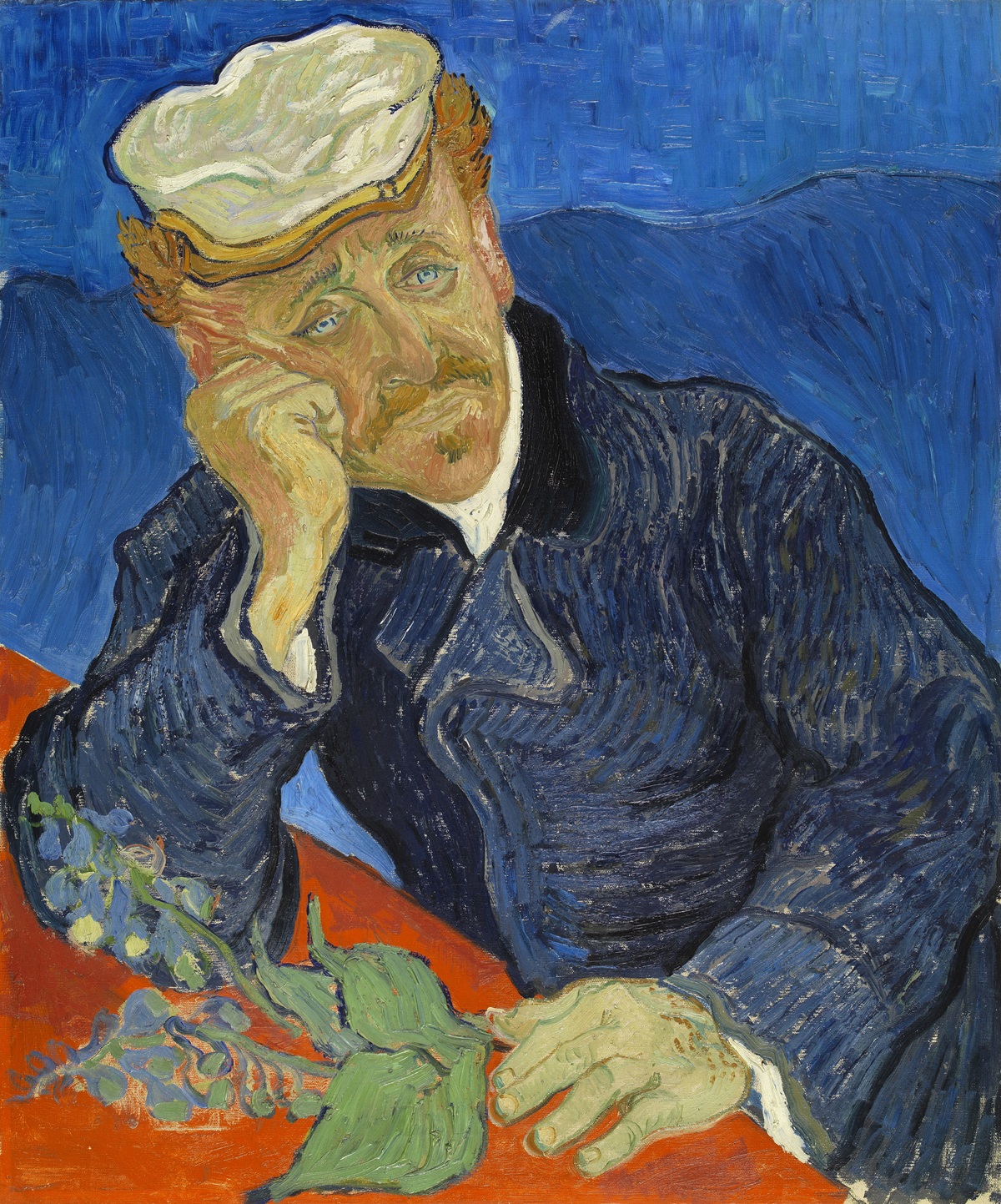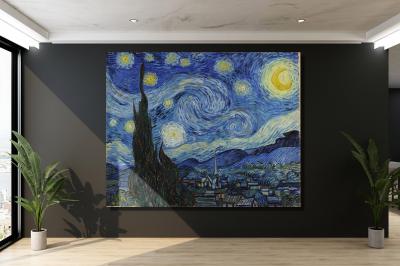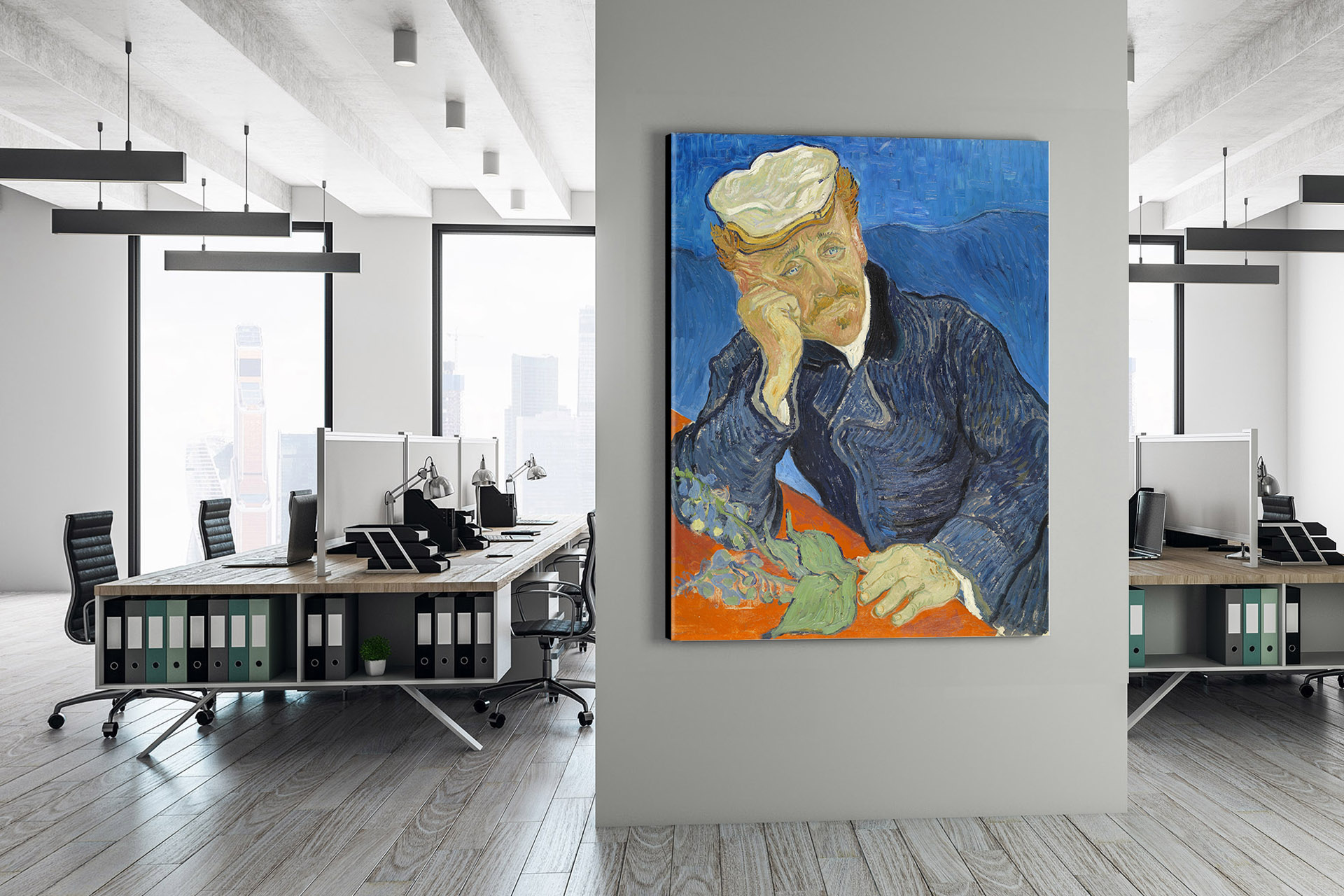Portrait of Dr. Gachet
By Vincent van Gogh, 1890
Portrait of Dr. Gachet: Vincent van Gogh’s Profound Brush with Emotion
The world of art is filled with remarkable masterpieces, but few are as emotionally charged and profoundly captivating as Vincent van Gogh’s “Portrait of Dr. Gachet.” This iconic painting not only showcases van Gogh’s artistic brilliance but also offers a poignant glimpse into the artist’s turbulent inner world during his final days. The subject of this mesmerizing portrait, Dr. Paul Gachet, adds another layer of intrigue to the narrative. In this extensive exploration, we will delve deeply into the captivating story behind “Portrait of Dr. Gachet,” shedding light on the lives of both the artist and his subject, while dissecting the profound emotional resonance of this timeless masterpiece. Additionally, we will examine the technical challenges van Gogh faced and the significance of the painting’s location. Finally, we will explore the life and legacy of the masterful painter himself.
The Enigmatic Dr. Gachet
Dr. Paul Gachet, a homeopathic physician, found himself intertwined with the life of Vincent van Gogh during the artist’s tumultuous final months in Auvers-sur-Oise, a quaint village in France. Van Gogh had sought refuge there, yearning for a change of scenery and solace from his ongoing struggles with mental illness. Dr. Gachet, with his medical expertise and compassionate nature, became a lifeline for the tormented artist.
Vincent van Gogh painted “Portrait of Dr. Gachet” in June 1890, just weeks before his tragic suicide. The painting captures the complexity of their relationship, showcasing Dr. Gachet’s contemplative and empathetic demeanor, which likely provided van Gogh with some semblance of comfort during his darkest hours. Dr. Gachet’s expertise in treating mental health issues, as well as his friendship, made him a unique and pivotal figure in the artist’s life.
“Portrait of Dr. Gachet” Large Canvas Prints from WhiteClouds
The Emotional Turmoil of Van Gogh
“Portrait of Dr. Gachet” transcends the realm of portraiture; it is a visceral representation of van Gogh’s emotional turmoil. The artist’s signature bold brushwork and vibrant color palette are at their zenith in this work, demonstrating the intensity of his feelings. Van Gogh employs a spectrum of blue and green hues to convey his melancholic state, punctuated by the vivid red of Dr. Gachet’s beard and the poppy flowers on the table.
What is particularly striking about the portrait is the way van Gogh captures Dr. Gachet’s gaze. The doctor’s eyes are deep and contemplative, reflecting both empathy and understanding. In this portrait, van Gogh seems to be not merely painting a likeness but capturing the essence of a man who provided him with solace during his darkest hours.
Symbolism and Expressive Techniques
Van Gogh’s artistic genius is brilliantly showcased in his choice of symbolic elements within the portrait. The poppy flowers on the table carry a dual meaning: they are a symbol of both sleep and death. This dual symbolism can be interpreted as a reflection of van Gogh’s own inner turmoil and perhaps an acknowledgment of his impending fate.
The distinctive, almost frenetic, brushwork seen in “Portrait of Dr. Gachet” serves as a direct manifestation of van Gogh’s inner chaos. His turbulent emotions appear to erupt onto the canvas, with each brushstroke conveying the intensity of his feelings. This approach is characteristic of van Gogh’s late work, where he used his unique style to convey the profound emotions that consumed him.
Technical Challenges and Location
Vincent van Gogh faced several technical challenges while painting “Portrait of Dr. Gachet.” His mental state was fragile, and he struggled with the effects of his mental illness, including depression and hallucinations. These challenges made the creative process particularly demanding for the artist, yet he channeled his inner turmoil into the painting, resulting in a work of extraordinary emotional depth and power.
The location of the painting, Auvers-sur-Oise, also played a significant role in its creation. The picturesque French village provided a tranquil and inspirational backdrop for van Gogh’s late works. The idyllic landscapes and quaint surroundings may have offered the artist a brief respite from his inner turmoil, allowing him to focus on his art.
The Life and Legacy of Vincent van Gogh
Vincent van Gogh’s life was marked by both artistic brilliance and personal turmoil. Born in 1853 in the Netherlands, he initially pursued a career in various professions, including art dealing and religious ministry, before dedicating himself to art. Throughout his career, van Gogh produced over 2,100 artworks, including paintings, drawings, and sketches.
Despite his prolific output, van Gogh struggled with mental health issues and poverty, which hindered his recognition as an artist during his lifetime. Tragically, he passed away in 1890 at the age of 37, having never experienced the full extent of the acclaim and success that would later follow his work.
Van Gogh’s legacy is immeasurable. His unique style, characterized by bold colors, dramatic brushwork, and emotional depth, had a profound influence on the development of modern art. Today, his paintings are celebrated worldwide, and he is regarded as one of the most influential artists in history.
 Portrait of Dr. Gachet by Vincent Van Gogh
Portrait of Dr. Gachet by Vincent Van Gogh
Conclusion
Vincent van Gogh’s “Portrait of Dr. Gachet” is more than just a portrait; it is a powerful testament to the artist’s emotional struggles and his deep connection with Dr. Paul Gachet. Through his masterful use of color, brushwork, and symbolism, van Gogh was able to convey the profound emotions that consumed him during his final days. This iconic masterpiece continues to touch the hearts and minds of those who encounter it, reminding us of the enduring power of art to convey the depth of human emotion and connection. As we contemplate this masterpiece, we can only marvel at the genius of van Gogh and the timeless beauty of “Portrait of Dr. Gachet,” set against the backdrop of the tranquil village of Auvers-sur-Oise, where the artist found both inspiration and solace amidst his profound turmoil. Vincent van Gogh’s life and work serve as a poignant reminder of the enduring impact of art on the human soul and the indomitable spirit of creative expression.
Frequently Asked Questions About “Portrait of Dr. Gachet”
Who is Dr. Gachet, and why did Vincent van Gogh paint his portrait? Dr. Paul Gachet was a homeopathic physician who treated Vincent van Gogh during his time in Auvers-sur-Oise, France. Van Gogh painted his portrait as a way of expressing his appreciation for Gachet’s care and companionship during his difficult mental health struggles.
What is the significance of the poppy flowers in “Portrait of Dr. Gachet”? The poppy flowers in the painting are symbolic. They can represent both sleep and death, reflecting van Gogh’s own emotional turmoil and the fragility of life.
Where can I see the original “Portrait of Dr. Gachet” painting? The original “Portrait of Dr. Gachet” is housed in the Musée d’Orsay in Paris, France, as part of its impressive collection of Impressionist and Post-Impressionist artworks.
How did Vincent van Gogh’s mental health issues influence the creation of this painting? Van Gogh’s mental health issues had a profound impact on his art. During his stay in Auvers-sur-Oise, he painted with great intensity, using his art as a way to express his emotions and inner turmoil. “Portrait of Dr. Gachet” reflects this emotional intensity.
What is the story behind the artist’s relationship with Dr. Paul Gachet? Dr. Gachet not only treated van Gogh medically but also provided emotional support and friendship. Van Gogh found solace in Gachet’s company during his final months, which is reflected in the emotional depth of the portrait.
Are there any hidden symbols or meanings in the painting? While the main symbols in the painting are relatively straightforward, there may be subtle details that art historians continue to study for hidden meanings or messages.
What is the current value of “Portrait of Dr. Gachet”? The value of “Portrait of Dr. Gachet” is incalculable due to its significance in the art world and its place in art history. However, it is often considered one of the most valuable paintings ever sold, with one version of the painting having been sold for over $80 million in the 1990s.
How did Vincent van Gogh’s artistic style evolve during his career, and how is it reflected in this painting? Van Gogh’s style evolved from his early dark and somber works to his later bright and expressive Post-Impressionist style. “Portrait of Dr. Gachet” is a prime example of his late style, characterized by bold colors and expressive brushwork.
What techniques and materials did van Gogh use to create “Portrait of Dr. Gachet”? Van Gogh used oil on canvas for this painting. He applied thick, textured brushstrokes, creating a highly tactile and emotional surface.
What impact did “Portrait of Dr. Gachet” have on the art world and van Gogh’s legacy? The painting solidified van Gogh’s reputation as a master artist, and it remains one of his most iconic works. It also contributed to the recognition of Post-Impressionism as an important art movement.
How many versions of “Portrait of Dr. Gachet” did van Gogh create, and where are they now? Van Gogh created two versions of “Portrait of Dr. Gachet,” one in June 1890 and another shortly after. The first version is in the Musée d’Orsay, and the second is in a private collection.
Are there any controversies or mysteries surrounding the painting’s history? There have been debates about the authenticity of some versions of the painting, as well as questions about its provenance and ownership history.
What was the critical reception of the painting during van Gogh’s time? The critical reception of “Portrait of Dr. Gachet” during van Gogh’s time was mixed. Some appreciated its emotional intensity, while others found fault with its unconventional style.
How has the painting influenced other artists or works of art? “Portrait of Dr. Gachet” has influenced countless artists and continues to inspire contemporary painters who admire van Gogh’s emotional depth and expressive technique.
What role did the location of Auvers-sur-Oise play in the creation of the painting? Auvers-sur-Oise provided van Gogh with a picturesque and tranquil setting that influenced the mood and subject matter of many of his late works, including “Portrait of Dr. Gachet.”
Are there any notable anecdotes or stories associated with the painting and its subject? Dr. Gachet himself was an eccentric character and a friend to several artists. His association with van Gogh and the portrayal in the painting have made him a subject of interest among art enthusiasts.
Has “Portrait of Dr. Gachet” ever been stolen or involved in art-related crimes? The original painting has not been stolen or involved in any major art-related crimes, but it has been the target of art theft plots and conspiracies in the past.
What insights into van Gogh’s emotional state can we gain from analyzing this particular portrait? “Portrait of Dr. Gachet” provides a profound insight into van Gogh’s emotional turmoil during his final days. His use of color, brushwork, and subject matter all convey the intensity of his emotions and his struggles with mental health.
How has the painting been preserved and restored over the years? The painting has undergone careful preservation and restoration efforts to maintain its integrity and ensure its longevity. Conservation experts have worked to protect it from environmental and physical damage.
What books, documentaries, or exhibitions are recommended for those interested in learning more about “Portrait of Dr. Gachet” and Vincent van Gogh’s life and work? Several books, documentaries, and exhibitions are available for those eager to explore “Portrait of Dr. Gachet” and the life of Vincent van Gogh in greater depth. Some notable resources include “Van Gogh: The Life” by Steven Naifeh and Gregory White Smith, documentaries like “Vincent van Gogh: Painted with Words,” and exhibitions at major art museums worldwide that feature van Gogh’s works.
Other Articles on Vincent van Gogh Paintings
At Eternities Gate by Vincent Van Gogh, 1890
Blossoming Almond Tree by Vincent Van Gogh, 1890
Cafe Terrace at Night by Vincent Van Gogh, 1888
Daubigneys Garden by Vincent Van Gogh, 1890
Green Wheat Field with Cypress by Vincent Van Gogh, 1889
Houses at Auvers by Vincent Van Gogh, 1890
Irises by Vincent Van Gogh, 1889
Night Café by Vincent Van Gogh, 1888
Portrait of Dr. Gachet by Vincent Van Gogh, 1890
Red Vineyards by Vincent Van Gogh, 1888
Road with Cypress and Star by Vincent Van Gogh, 1890
Starry Night by Vincent Van Gogh, 1889
Starry Night over the Rhone by Vincent Van Gogh, 1888
Sunflowers by Vincent Van Gogh, 1887
The Bedroom by Vincent Van Gogh, 1888
The Church at Aurers by Vincent Van Gogh, 1890
The Garden of the Asylum by Vincent Van Gogh, 1889
The Mulberry Tree by Vincent Van Gogh, 1889
The Potato Eaters by Vincent Van Gogh, 1885
The Yellow House by Vincent Van Gogh, 1888
Tree Roots by Vincent Van Gogh, 1890
Van Gogh Self Portrait by Vincent Van Gogh, 1887
Vase with Red Poppies by Vincent Van Gogh, 1886
View of Arles by Vincent Van Gogh, 1889
Wheat Field with Crows by Vincent Van Gogh, 1890
Wheat Field with Cypresses by Vincent Van Gogh, 1889
More WhiteClouds Videos
Contact us today to learn more about our 3D services and how we can help you achieve your goals.

